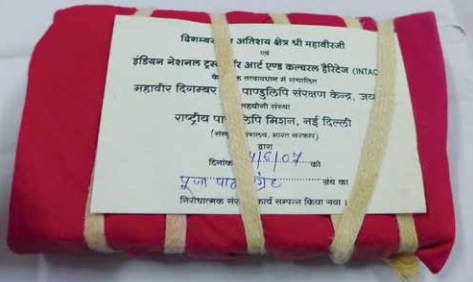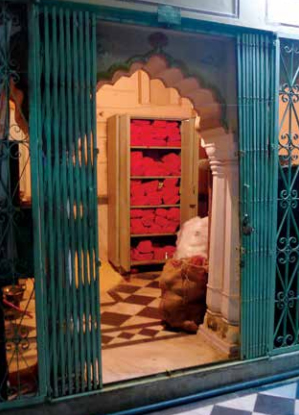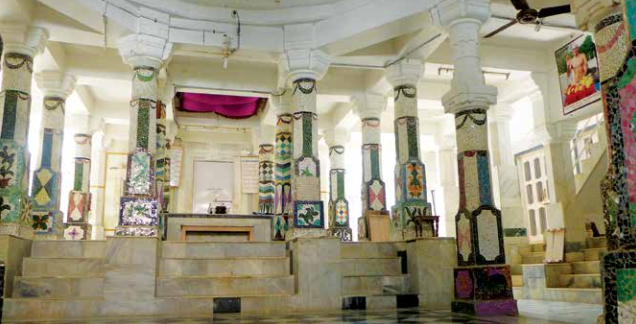
Centre of Jaina Studies Newsletter: SOAS - University of London
Bhaṭṭāraka lineages proliferated throughout Western and Central India especially in the 15th and 16th centuries, and continued to flourish and multiply in the 17th to 18th centuries. Though by the 19th century they seem to have lost much of their influence, most lineages were discontinued only in 20th century. The age of the manuscripts in the collections (bhaṇḍāra) discussed here parallel the rising and declining fortunes of the bhaṭṭāraka lineages themselves. The majority date from the 16th to 18th centuries, less to the 15th and 19th centuries, and yet fewer earlier or later that that. The bhaṭṭārakas' bhaṇḍāras typically contained a broad range of texts, including various genres of literature, ritual and devotional compositions, philosophical works, texts on conduct, grammar and poetics, mathematical, astrological and ayurvedic works, and small numbers of non-Jaina texts.
The seats of most bhaṭṭāraka lineages are known to have shifted regularly between various cities and towns, presumably according to political conditions, or more directly following patterns of lay migration, which in turn depended on changing economic opportunities. From the colophons it is clear that many of the texts were composed, or copies made, at various consecutive seats or yet elsewhere. We can safely assume that when relocating their seats, bhaṭṭārakas often took along their manuscript collections or at least parts thereof.
Guṭakās or bound manuscripts make up an important part of most bhaṭṭāraka bhaṇḍāras. Often thought of as having been personal notebooks, guṭakās were typically anthologies of miscellaneous, short compositions ranging from devotional and ritual to philosophical texts, and sometimes included literature not found elsewhere. Though thus far little studied, they form a particularly interesting source for the study of the former usage of manuscripts, and of early modern Digambara renouncers' practices more broadly.

A guṭakā of the Āmera śāstrabhaṇḍāra wrapped in protective cloth (veṣṭaṇa), with index card informing of the manuscript's general contents and the date of its preservative treatment. February 2013.
In an earlier issue of Jaina Studies, Balcerowicz (2015) reported on Digambara manuscript collections from across the length and breadth of India.The present article adds information on the manuscript libraries of some bhaṭṭāraka seats of Western and Central India visited by the author in the past years. I first report on a number of collections connected to the Mūlasaṅgha Balātkāragaṇa, and then add shorter references to known Kāṣṭhāsaṅgha and Senagaṇa bhaṇḍāras. While a thorough study of the general contents of these libraries and a discussion of specifically noteworthy texts preserved therein lies beyond the scope of this report, it is hoped that sharing information on the collections' whereabouts will contribute to their further exploration.
Jaipur
Most bhaṭṭāraka bhaṇḍāras are still preserved in their traditional setting, at the mandiras where the last incumbents of the various lineages had their seats. A single exception is the Āmera śāstra-bhaṇḍāra in Jaipur, one of the best known and most regularly consulted Digambara manuscript collections in the region.[1] The nucleus of the current collection is the bhaṇḍāra of the former Mūlasaṅgha Balātkāragaṇa branch referred to by Joharāpurakara (1958: 97-113) as the DillīJayapuraśākhā, which before the foundation of Jaipur in 1727 was located at nearby Āmera. Apparently in the 1940s, after a period of neglect,[2] a collection of 1,600 (remaining?) manuscripts was brought to Jaipur from the former bhaṭṭāraka seat in Āmera, the Nemiṇātha Sāṃvalajī Mandira. The manuscripts were first deposited for some years in a layman's house, then shifted to a dedicated building, the Mahāvīra Bhavana, where a research institute and a publishing house were established, the Jaina Vidyā Saṃsthāna. Manuscripts were brought over from the pilgrimage site Atiśaya Kṣetra Mahāvīrajī, the seat of the last Dillī-Jayapuraśākhā bhaṭṭāraka Candrakīrti (died 1968/9 CE), and added to the collection. In 1988, the collection and research institute shifted to the Digambara Jaina Nasiyāṃ Bhaṭṭārakajī at Narayan Singh Circle (Detige, 2014), where the Apabhraṃśa Sāhitya Akādamī was established, a centre of research and teaching on Apabhraṃśa, Prakrit, and Jainism directed by Kamalacanda Sogāṇī. For several years, plans have been underway for a new building with improved facilities a few miles further South in Mālavīya Nagara, and the relocation should be underway at the time of this publication. The collection has been further expanded with endowments from private collections, and is now nearing 6,000 manuscripts, including more than 700 guṭakās.[3] Rarely available elsewhere, a handwritten catalogue volume of the guṭakās produced in the 20th century lists in detail their contents, disclosing this collection of guṭakās in its totality as a resource for the study of local literary history, practical or ritual canons, and book history.
Ajmer
Different paths of the development of Jaina manuscript libraries are exemplified by the bhaṇḍāras of the two bhaṭṭāraka lineages referred to in sum by Joharāpurakara (1958: 114-25) as the Balātkāragaṇa Nāgauraśākhā, which ultimately settled in Ajmer and Nagaur respectively. The Ajmer lineage's last incumbent was Bhaṭṭāraka Harṣakīrti, who was still active in the mid20th century. The manuscript collection of this lineage is preserved at its former seat, the Digambara Jaina Mandira Baṛā Dhaṛā (Bābājī kā Mandira) in the Sarāvagī Mohallā neighborhood in Ajmer (26°27'30.6"N 74°37'50.3"E). Bhaṇḍāras kept at mandiras are typically managed by the elected temple trust. As is often the case elsewhere, the Ajmer collection has most recently been catalogued by a specialized outsider organization, in this case the Satśruta Prabhāvanā Ṭrasṭa Bhāvanagara, referred to in short as the 'Bhāvnagarvāle'. Their catalogue contains over 2,000 loose folio manuscripts and 450 guṭakās. While modest in comparison to both the previous and the following bhaṇḍāras discussed here, this is a substantial collection in its own right, filling more than two cupboards (alamārī) with well-preserved bundles of manuscripts wrapped in the distinct red cloth.
Nagaur
The second Balātkāragaṇa Nāgauraśākhā branch ended after the death of Bhaṭṭāraka Devendrakīrti in 19667. Its vast manuscript collection is currently housed in an annex to the former seat, the Bīsapantha Baṛā Mandira in Nagaur (27°12'06.6"N 73°44'21.3"E). An epigraph above the entrance indicates the repository was built by Bhaṭṭāraka Devendrakīrti in 1953, naming it the Bhaṭṭāraka Munīndrakīrti Digambara Jaina Sarasvatī Bhavana, apparently in homage to a late 19thcentury predecessor. Before its split into the Ajmer and Nagaur branches, the Nāgauraśākhā first had its main seat in Nagaur under two consecutive 17th-century incumbents. Before that and again afterwards, until it came to settle in Nagaur, the seat of the 'Nagaur' branch shifted between other towns in the Śākambharī region (Joharāpurakara, 1958: 124). Much of the collection of 15,000 manuscripts (P.C. Jain, 1981: xxv), amongst which more than a thousand guṭakās (P.C. Jain, 1985) can be expected to have been composed or copied elsewhere. In size, the Nagaur collection surpasses even the Āmera-śāstra bhaṇḍāra, and is particularly important for its rich collection of Apabhraṃśa texts. At the time of a visit to Nagaur in February 2013, I was only permitted 'darśana' of the manuscript alamārīs and a few bundles of manuscripts. The available catalogue volumes (P.C. Jain, 1981, 1985, 2009), however, show this bhaṇḍāra to be tantalizingly rich.

An opened manuscript alamārī in a side room of the Baṛā Dhaṛā Mandira, Ajmer. February 2013.
Īḍara
Another important Balātkāragaṇa collection was developed by the so-called Īḍaraśākhā (Joharāpurakara, 1958: 136-58), which together with its sister lineage the Bhānapuraśākhā (Ibid.: 161-8) was active in the Vāgaḍā region. Īḍara was the seat of later-day incumbents of the former lineage, but it seems to have been based further North at first, in Sāgavāḍā in the 16th and 17th centuries and possibly in Udaipur in the early 18th century. The Īḍaraśākhā was discontinued at the turn of the 20th century, after the death of the lineage's last full bhaṭṭāraka, Kanakakīrti. At the Pārśvanātha Digambara Jaina Prācīna Jinālaya (23°50'52.9"N 73°00'04.7"E), the seat in Īḍara, the lineage's manuscript collection is preserved in a dedicated room named after its founder, the Bhaṭṭāraka Ācārya Sakalakīrti Prācīna Śruta-bhaṇḍāra. According to the local caretakers, a substantial part of the collection was lost in previous decades, allegedly stolen. Yet the bhaṇḍāra remains an important one. A handwritten catalogue available onsite lists numerous compositions, possibly autographs, by the prolific litterateurs for which this Balātkāragaṇa lineage is reknown, bhaṭṭārakas as well as brahmacārīs.

Maṇḍapa of the Pārśvanātha Digambara Jaina Prācīna Jinālaya in Īḍara, still hosting the grantha-bhaṇḍāra of the eponymous Balātkāragaṇa Īḍaraśākhā. January 2014.
Sonagiri
A bhaṇḍāra at the important Digambara pilgrimage hill (siddha-kṣetra) Sonagiri was formerly under the custody of the eponymous Mūlasaṅgha Balātkāragaṇa Sonagiriśākhā bhaṭṭārakas (Joharāpurakara, 1958: 233, 235). The lineage was originally connected at least as strongly to Gwalior, but later settled to the south in Sonagiri. It was discontinued, and in practical terms replaced by a lay trust, after the death in 1974 of Bhaṭṭāraka Candrabhūṣaṇa, the penultimate bhaṭṭāraka of West and Central India. At the central courtyard of the former bhaṭṭāraka seat, referred to as the Bhaṭṭāraka Koṭhī (mandira no. 8-9), a room is still marked as having formerly been the 'depository of handwritten scriptures' (hastalikhita śāstra bhaṇḍāra). By the time of my visit (December 2013), the collection had been transferred to a more recent building across the road (mandira no. 11-12, 25°43'11.7"N 78°22'44.9"E), where caraṇa-chatarīs of four Sonagiri bhaṭṭārakas are also found. The collection had been catalogued earlier on, and a set of CD-roms was shown to me containing scans of several dozen rare, old, or otherwise noteworthy manuscripts. In its new location, however, the bundles had been placed out of order and no catalogue could be produced. Worst of all, many of the alamārīs did not close properly and were infested with bugs. Left without proper care, bhaṇḍāras may be lost within a short span of just a few years. Though precise information is missing, the collection I was able to only randomly consult comprised at least a few thousand manuscripts.
Kārañjā and Nagpur
Named after its seat at Kārañjā (Maharashtra), the Balātkāragaṇa Kārañjāśākhā saw its last incumbent in Bhaṭṭāraka Devendrakīrti, who died in 1916. Now managed by a few enthusiasts and local laymen, and containing over 1,100 paper and some 50 palmleaf manuscripts, its bhaṇḍāra is still kept at the former seat, the Mūlasaṅgha Candranātha Svāmī Balātkāragaṇa Digambara Jaina Mandira (20°28'48.6"N 77°29'30.5"E). This collection's condition is superb, all manuscripts which I saw being unblemished copies. At the time of my visit acid-free inlay sheets had just been fitted between the folios of each manuscript to prevent the pages from sticking together over time. At the Pārśvaprabhu Digambara Jaina Moṭhe Mandira in the Lāḍapurā neighbourhood in nearby Nagpur (21°09'05.6"N 79°06'37.7"E), a temple connected to the same bhaṭṭāraka lineage, a modest manuscript library is also found. This collection largely consists of more recent manuscripts, and has been catalogued by the Kundakunda Jñānapīṭha in Indore.
Further Balātkāragaṇa bhaṇḍāras
A small bhaṇḍāra at the Digambara Jaina Mandira in Aṭera (26°44'57.7"N 78°38'26.5"E) was probably related to the so-called Balātkāragaṇa Aṭeraśākhā. Nothing is known about its contents and about the (assumed) existence, current location, and fate of the manuscript collections of further Balātkāragaṇa lineages and sub-lineages, notably the two branches of the Sūrataśākhā and the sub-lineages of its earlier offspring, the Jerahaṭaśākhā, which spread through Malwa.[4]
Kāṣṭhāsaṅgha and Senagaṇa collections
So far, I have discussed manuscript collections of Balātkāragaṇa lineages. I now turn to a more brief discussion of bhaṇḍāras of a few other bhaṭṭāraka traditions. Kārañjā, to start travelling North again from there, is known to have been home to no less than three bhaṭṭāraka seats (Detige, 2015). A substantial bhaṇḍāra is found at the Digambara Jaina Pārśvanātha Svāmī Senagaṇa Mandira, a seat of the Mūlasaṅgha Senagaṇa for several centuries, and the Senagaṇa's only branch in the region under discussion here. References are found to various Kāṣṭhāsaṅgha lineages at Kārañjā's Candranātha Svāmī Kāṣṭhāsaṅgha Digambara Jaina Mandira, yet it's manuscript library is more modest (Ibid.: 156-9).
A single manuscript alamārī is preserved at the Mahāvīra Svāmī Digambara Jaina Mandira in Aṅkleśvara (near Surat), a temple that was connected to the Kāṣṭhāsaṅgha Nandītaṭagaccha. A larger manuscript collection related to the Nandītaṭagaccha is found in Ṛṣabhadeva-Kesariyājī, an important pilgrimage site to the South of Udaipur. It is kept at the Bhaṭṭāraka Bhavana (24°04'36.5"N 73°41'27.6"E), the residence of Bhaṭṭāraka Yaśakīrti, who was also connected to Pratāpagaṛha and died in 1978 CE as the last bhaṭṭāraka North of the Godavari river. I could not consult the collection, but Kasliwal (1967: 116) reported it contains over a thousand manuscripts.
Kāṣṭhāsaṅgha Nandītaṭagaccha and Māthuragaccha lineages branched out across the region not unlike those of the Mūlasaṅgha Balātkāragaṇa. Their history, however, is still far less well documented, and accordingly less is known about the existence and location of further Kāṣṭhāsaṅgha bhaṇḍāras. It is possible that their collections never developed to the same extent as their Balātkāragaṇa counterparts, given that the Kāṣṭhāsaṅgha seats seem to have been relocated at least as frequently, and seemingly more widely, than those of the Balātkāragaṇa.
References
Balcerowicz, Piotr. 'Digambara Jaina Collections of Manuscripts'. Jaina Studies: Newsletter of the Centre of Jaina Studies 10 (2015) 48-50.
Detige, Tillo. 'Worshipping Bhaṭṭārakas'. Jaina Studies: Newsletter of the Centre of Jaina Studies 9 (2014) 27-30.
Detige, Tillo. 'The Bhaṭṭārakas of Kārañjā (Lāḍa): Triveṇī Saṅgama at Jaina Kāśī'. In: Luitgard Soni & Jayandra Soni (eds.) Sanmati, Essays Felicitating Professor Hampa Nagarajaiah on the Occasion of his 80th Birthday, 143-176. Bengaluru: Sapna Book House, 2015.
Jain, Prem Chand. A Descriptive Catalogue of Manuscripts in the Bhattarkiya Grantha Bhandar Nagaur. Vol. I-IV. Jaipur: Centre for Jain Studies, University of Rajasthan, 1979, 1981, 1985, 2009.
Joharāpurakara, Vidyādhara. Bhaṭṭāraka Sampradāya. Śolāpura: Jaina Saṃskṛti Saṃrakṣaka Saṅgha, 1958.
Kasliwal, Kastoor Chand. Jaina Grantha Bhaṇḍārs in Rājāsthān. Jaipur: Digamber Jain Atishaya Kshetra Shri Mahavirji, Mahavir Bhawan, 1967.
Kāsalīvāla, Kastūracanda. Āmera śāstra-bhaṇḍāra, Jayapura kī Grantha Sūcī. Jayapura: Digambara Jaina Mahāvīra Atiśaya Kṣetra Kameṭī, 1949.
Kragh, Ulrich Timme. 'Localized Literary History: Subtext and Cultural Heritage in the Āmer Śāstrabhaṇḍār, A Digambara Manuscript Repository in Jaipur'. International Journal of Jaina Studies 9, 3 (2013) 1-53.
All photos are by Tillo Detige.
Tillo Detige teaches at Ghent University, where he is currently also finalizing his doctoral dissertation. His research project on 'Early Modern Digambara Jainism in Western India: The Age of the Bhaṭṭārakas?', funded by the Research Foundation Flanders (FWO), led him to the manuscript collections of Western and Central India.
Kāsalīvāla (1949) catalogues both the original bhaṭṭārakīya bhaṇḍāra of Āmera and the collection of the Mahāvīrajī. In Kragh (2013), the Āmera library stands as a case-study for 'localized literary history'.
 Tillo Detige
Tillo Detige